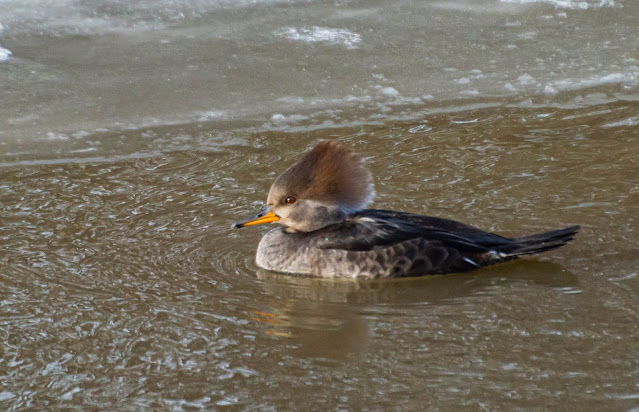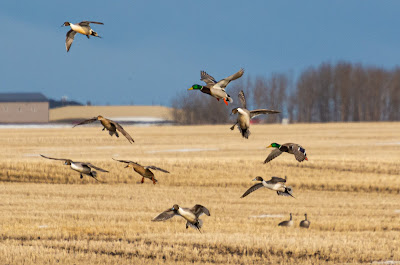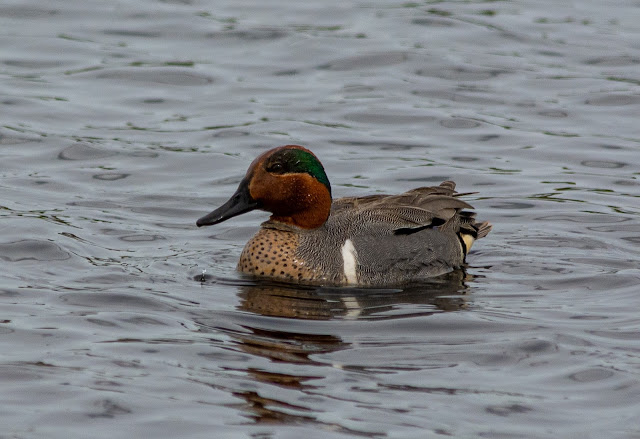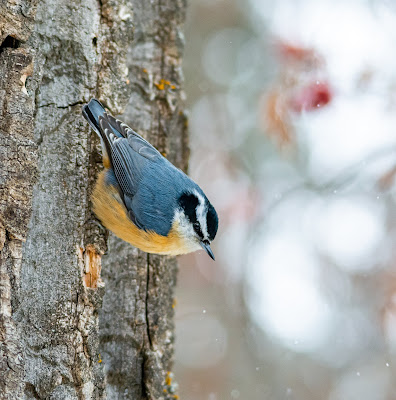Quack-Up: A Guide to Alberta Ducks
Have you ever stopped to think about how many ducks are out there in the Alberta wilderness? For a northern, landlocked region, we aren't short on ducks or duck species. While many folks might first think of plain white farm ducks when considering these web-footed birds, our wild ducks come in a great variety of shapes and sizes. While some are widespread and found all over the province, others are more specialized, preferring prairie sloughs, boreal bogs, or swift mountain streams. Let's take a glance over Alberta's different duck varieties.
First of all, what is a duck? Silly question, everyone knows what a duck is. But what makes ducks different from things like geese and swans? All these birds are in the family Anatidae, the duck-billed, web-footed, water-loving group of birds that arose in the late Paleogene period, although duck-like birds existed near the end of the age of dinosaurs. Within this, geese and swans are more closely related to each other, both belonging to the subfamily Anserinae which tend to be larger with longer necks and, barring a few exceptions, prefer northern areas. Ducks are basically what we call all other anatids that aren't geese or swans. There are many different subfamilies and evolutionary tribes of ducks out there, which we'll look at now.
Anatinae - Dabbling Ducks
Your general or basal anatids are nicknamed the 'dabbling ducks', also known as 'puddle ducks'. If you go to your average neighborhood pond or large roadside puddle, chances are you'll see a fair few dabbling ducks. As the name suggest, dabbling ducks tend to dabble at the water's surface for plants, seeds, and aquatic insects. Many of these species were once grouped together under the genus Anas, the Latin word for duck, but more recent DNA evidence has divided them under different names. By far the most commonly seen Anas duck in Alberta is the Mallard (Anas platyrhynchos). Just about any wetland across the province will have at least a pair of these ducks. They're also one of the first to arrive, usually by April. The male Mallard, as with all ducks, is easier to identify with its characteristic green head, yellow bill, and white neck collar. In late summer, though, they molt into their non-breeding plumage and can look almost identical to the females. You can still tell them apart, however, because the male retains his yellow bill while the female always has an orange bill with dark blotches. Mallards are fairly bold and tolerant of people, so they're easy to see near human settlements. They're also not terribly fussy, it seems, when it comes to selecting mates- Mallards have been known to hybridize fairly often with other dabbling duck species as well as some diving ducks. They make that classic quacking noise we most commonly associate ducks with.
 |
| A male Mallard Duck flying overhead. By Nick Carter |
There's also the Northern Pintail (Anas acuta) which arrives in early spring in massive flocks before dispersing. The male pintail is handsome with his brown head and long, elegant tail feathers. Females are similar to mallards but the bill is blue, not orange and black. Males produce thin, wheezy whistles, females quack like mallards. Look for them staging in huge flocks on agricultural fields during migration, and on shallow marshes with other dabbling ducks in the summer.
Our third Anas species is the Green-winged Teal (Anas carolinensis). It's also our smallest dabbling duck, noticeably tinier and more shy than the Mallard. Sit quietly at your local wetland during late spring, however, and chances are a pair of Green-winged Teals will emerge from the reeds. Both sexes do indeed have a bright green patch on the wing, but the green and brown head of the male is an easier field marker. Males produce a high, piping whistle, while mostly silent females occasionally make a horse, raspy quack.
Another common dabbling duck genus is Spatula. Yes, just like the cooking utensil. The name comes from the bill shape of the Northern Shoveler (Spatula clypeata) which is longer and flatter at the tip than any other Alberta duck, giving them a slightly comical appearance. Using their spoon-like bills with long keratinous strainers, shovelers filter out plants and insects from the water's surface. They can be mistaken at first glance for a Mallard with their bright green heads, but male shovelers have a white underside with distinctive chestnut patches on the flanks. With females, the best tell is the long orange and black bill. Shovelers are common across the province. Males make a wheezy clucking noise, females give a nasally quack.
 |
| Male Northern Shoveler, awkwardly trying to groom himself with that huge bill. By Nick Carter |
Two other 'teals' are also related to the Northern Shoveler, though neither look much like it. The Blue-winged Teal (Spatula discors) is a common yet cute little duck of shallow ponds and wetlands throughout the province. In addition to the vivid blue patch on their wings (which is easier to see while in flight), the male has a lovely blue head with distinct white crescents between the eyes and bill (known at the loral region). Blue-winged Teals tend to be early arrivals in spring after the Mallards, pintails, and shovelers have shown up, but they also leave early in the fall as well. Both sexes have high-pitched voices- males make soft squeaks, females quack loudly. The Cinnamon Teal (Spatula cyanoptera), ironically, has bright blue wing patches as well, but the male is a deep rusty colour with blood-red eyes. This makes them easy to tell apart from Blue-winged Teals. Females are trickier. Cinnamon Teals are mostly found in the southeastern Alberta prairies, but sightings around the Edmonton and Grande Prairie areas could indicate they're slowly spreading northwest despite their sadly declining population. Both sexes make various, rattling grunts.
 |
| Cinnamon Teal female (right) and male (left). By Nick Carter |
Last of the classic dabbling ducks are the plant-eating Mareca ducks, the wigeons. The American Wigeon (Mareca americana) is a fairly common duck throughout the province. Its short blue bill tipped with black, big round head, deep green eye stripes and pale crown make this duck easy to identify. It makes a wheezy squeaking sound a bit like an old rubber duck. Females look fairly similar to the males, just without the pale and green head colouring. There's also the Eurasian Wigeon (Mareca penelope), a visitor from, well, Eurasia that pops up in North America in small numbers each year. A close relative of the wigeons is the Gadwall, a relatively plain-looking duck. Even the males are a subdued mixtures of browns, greys, blacks, and whites. The female looks almost identical to a female mallard, but has a thinner, darker bill. Males produce a funny-sounding burp-like call that my friend Becca thinks sounds like a nasal "hey... hey...". Both species enjoy reedy lakes and ponds during summer.
 |
| American Wigeon male. By Nick Carter |
 |
| Male Gadwall, a subdued duck if there ever was one. By Nick Carter |
Mergini - Sea Ducks
Yes, there are 'sea ducks' in Alberta. Some sea ducks like eiders keep near the coasts all year, but many species migrate inland during the breeding season after a winter on shallow saltwater bays. Some populations even spend the whole year inland. Most species dive under water for crustaceans and other invertebrates. Some of them nest in tree cavities a bit like owls or woodpeckers, and will even nest in large enough bird boxes installed in wetland trees.
The most commonly seen sea duck genus in Alberta is probably Bucephala, the goldeneyes. The Common Goldeneye is (Bucephala clangula), indeed, well-represented across Alberta. The Barrow's Goldeneye (Bucephala islandica) is most easily found from the Rockies westward to the Pacific, but they sometimes make their way inland. I used to see them in rare but regular numbers in and around Grande Prairie. You can tell male Common and Barrow's Goldeneyes apart most easily by the white loral patch. In Barrow's it's teardrop-shaped, while in the Common Goldeneye it's fairly round. Barrow's also tend to have less white showing on the wings and flanks. Females are much trickier. The courtship displays of males are fun and funny to observe, with lots of dancing and head-bobbing. Neither species is terribly vocal. Both prefer lakes in forested regions during the breeding season. I normally hear them coming thanks to the sound of the air whistling through their wing feathers.
 |
| Male Common Goldeneye (top) and Barrow's Goldeneye (bottom). Can you spot the differences? By Nick Caretr |
The third, smaller Bucephala species is the Bufflehead (Bucephala albeola). It's a cute little duck, with its big round head, stumpy bill, and smiling jaw giving it a babyface look. In the males, that face is iridescent with a big white patch on the back of the head. Females are shades of grey with a fleck of white behind each eye. Despite their cuteness, Buffleheads can be fierce. I've witness aggressive fights between males during the breeding season. Nesting females give hoarse squawks, males give raspy grunts.
 |
| Bufflehead male, by Nick Carter |
The scoters, genus Melanitta, are handsome and mostly black sea ducks. The White-winged Scoter (Melanitta deglandi) is uncommon species found in most of Alberta outside the mountains. In addition to white wing patches, they also have white highlights on the eyes a bit like makeup. The bill is long, sloping, and hooked at the tip. In males, it has a bright pinkish tip. Look for families of this duck on big prairie lakes. Both sexes are mostly silent. The similar Surf Scoter (Melanitta perspicillata) often migrates through much of central Alberta to breeding grounds in the far north. Females are dark brown while males are a matte black with white stripes on the forehead and back of the neck. His huge bill is a brilliant orange, black, and white. They seem to appear during migration for a brief couple days at particular prairie and parkland lakes before moving further north to breed. Courting males make soft gurgling and piping calls.
 |
| Male Surf Scoter, photographed in Grande Prairie where flocks of these ducks have been reliably stopping off every spring during migration. By Nick Carter |
The mergansers, genus Mergus, are streamlined fish-eating specialists with narrow beaks bearing serrated edges and a hooked tip. The Common Merganser (Mergus merganser) is, naturally, one of the easier species to find. They tend to prefer rivers and streams in forested areas. I mostly see them in the Whitemud creek valley in Edmonton, or similar such places. Males look a bit like a goldeneye with their black-and-white bodies and green heads, but the lack of a white face patch, the brilliant red bill, and elongated shape gives them away. Females are of a similar build but with a greyish body and brown head, complete with a feathery mullet at the back of the head. Aside from raspy alarm or courtship calls, Common Mergansers are normally quiet. The similar Red-breasted Merganser (Mergus serrator) is like the Surf Scoter in that it winters along the coasts, before moving inland and far northwards to breed, so look for it passing through Alberta then. The male Red-breasted Merganser has a lovely black, white, and grey body plumage with a reddish-brown chest and white ring neck. The green head looks quite cartoonish, however, with its wild feathery hairdo and long, curved, skinny bill. The female is quite similar to the female Common Merganser, however it lacks the Common's white chin and breast, and has a longer, skinnier bill. Like the Common, Red-breasted Mergansers are normally silent.
 |
| Female (top) and male (bottom) Common Mergansers. By Nick Carter |
There's also the smaller, more distantly-related Hooded Merganser (Lophodytes cucullatus), a much more compact little duck that still bears the typical merganser bill and wild head crest. Males are black and white with brown flanks, and have yellow eyes and a great big white patch on either side of their feathery crest. From a distance at first glance, you might mistake one for a Bufflehead. Orange-eyed females are brown with a rusty-tinged crest. In Alberta they can be found on mountain lakes as well as prairie ponds during migration. I've seen them at Pyramid Lake in Jasper in mid October, and even in Grande Prairie in early November. Aside from a few throaty croaks, they too are a quiet duck.
 |
| Male (top) and female (bottom) Hooded Mergansers. By Nick Carter |
One beautiful mountain-dweller is the Harlequin Duck (Histrionicus histrionicus). These birds enjoy fast-moving mountain rivers where they battle the currents alongside the bravest white-water rafters. They suffer for their lifestyle too, enduring more broken bones than just about any other duck species. The male's plumage is striking, a mixture of blues, whites, and browns that earn it its common name, as does its squeaking. frenzied call. The female is, typically, more subdued in shades of grey and white. Keep an eye out form them along mountain rivers around the Jasper, Banff, and Canmore regions.
 |
| Harlequin Duck male (left) and female (right) on the Bow River near Canmore. By Nick Carter |
Last is the Long-tailed Duck (Clangula hyemalis), an impressive species that breeds in the high arctic, so northern Albertans must hope to see it pass through during migration. The male is white with smudgy grey and brown patches, a pink and black bill, and long, elegantly curved tail feathers. Females are somewhat similar but lack the elongate tail feathers. They produce rhythmic, honking yodels.
The Oxyurini are small, round ducks with stiff, upright tail feathers and big blue bills in the males. Only one species is found in Alberta, the Ruddy Duck (Oxyura jamaicensis). With its dumpy little build and red body with a black head and tail and white face mask, male Ruddy Ducks are comical little things. The quieter brownish female has more of a dignified air. They dive into shallow prairie wetlands for small invertebrates. Courting males beat their bill against the front of their neck, producing a swirl of bubbles in the water. His display call is a trilling click with a little burp at the end. Other than that, they're a quiet species.
 |
| Ruddy Duck male. By Nick Carter |
Probably the most common diving duck you'll see in Alberta is the Lesser Scaup (Aythya affinis). The male has a cookies-and-cream body colouring with a dark head and blue bill with a black tip. Females are more subdued in colour with a white patch at the base of the bill. They're found across most of Alberta, but normally only in the mountains during migration. Males are usually silent but females give off hoarse grunts and barks. There's also the deceptively similar Greater Scaup (Aythya marila). Telling scaups apart might be the hardest bit duck identification in the province, at least when it comes to the males. Lesser Scaups, however, are much more common in Alberta than Greaters are, as the latter rarely if ever breeds in Alberta, generally moving far north for the summer. Outside of migration season, it's usually safe to assume that any scaup seen in Alberta is a Lesser. That said, there are ways you can tell them apart, and the most reliable is the shape of the head. Lesser Scaups have a peak of feathers at the back of the head, descending into a straight lower head and neck. The Greater, on the other hand, has a much more evenly-rounded head. It takes practice to tell these apart, and to be honest I've never 100% confidently identified a Greater Scaup in the wild myself.
There's a third scaup-type duck that's thankfully easier to tell apart. The Ring-necked Duck (Aythya collaris) breeds from the central parkland region northwards. It does have a faint ring on its neck, but don't go looking for that in the field- this feature is normally only visible on dead and stuffed specimens in a lab, which is how this species got its name. Instead, the rings on the bill will tell you. Ring-necked Ducks have a scaup-like colouration but the white rings on the base of the bill and near the black tip distinguish this species. Females are naturally more drab but even in them the bill rings are visible. Ring-necks also have an obvious peaked head which is useful for telling them at a distance. Though less common than Lesser Scaups, if you know where to look for reliable Ring-necked Duck habitat you'll stand a chance of seeing one. At the time of this writing (spring of 2022) there's reliably been at least a couple pairs of this species at the Clifford E. Lee Nature Sanctuary west of Edmonton. They produce short, high-pitched barks and peeps. The Tufted Duck, which looks like a scaup with a mullet, is a rare visitor to the province from Eurasia.
Then there's the aptly-named Redhead (Aythya americana). With its blue bill, dark breast, and cinnamon head, the male is a handsome duck. Females are a medium-brown with dark eyes and a pale face. Like many other ducks, Redheads winter and migrate in huge flocks, resting on large lakes during their seasonal journeys, before spending the summer on shallow, reedy prairie ponds. Interestingly, Redheads will sometimes exhibit brood parasitism- the habit of one species of bird laying its eggs in the nest of another species, and saddling the hapless host with the burden of raising young that isn't theirs. Apparently, perhaps thanks to the phenomenon of imprinting leading young Redheads to think they're a different species, these ducks sometimes hybridize with other diving ducks. Few duck species are safe from Redhead parents shirking their responsibilities. Courting males produce a funny rising and descending call that sounds a bit like a tiny toy motor revving up. Females make various croaking and quacking sounds.
A somewhat similar relative to the Redhead is the Canvasback. This is a regal looking species with a long, sloping forehead, which is rust-coloured in the male, who also has a dark breast, bright pale body, and vivid red eyes. As usual, the female is similar in shape but more muted in colour, with dark eyes smudged with white streaks. The Canvasback is very similar to the European Pochard, but oddly enough Livezey (1996) found the latter species to be more closely related to the Redhead, with the Canvasback being a sister taxon to these two. Unlike many other diving ducks, Canvasbacks are mostly vegetarian, with tubers of aquatic plants like sago pondweed being a favored food. They're also a bit more shy and vary than scaups and Redheads, so patience is key when scoping out Canvasbacks. They breed in wetlands throughout much of the province east of the foothills, and are usually silent aside from their courtship grunts.
One last duck, an unusual outlier, is the Wood Duck (Aix sponsa). The genus Aix, which also includes the Mandarin Duck (Aix galericulata), is one that scientists haven't been able to place yet within the larger duck family. Aside from that, the Wood Duck is a small but beautiful species. The male is wildly multicoloured with iridescent greens and blues alongside areas of brown, black, and white. The female is a brown but with white eye spots and iridescent wing patches. Both sexes have a distinct, downward, pointing crest at the back of the head. Wood Ducks have an oddly patchy distribution across North America. They live in and around wooded ponds and swamps where they perch in trees and nest in tree cavities. They have strong claws for gripping branches. Outside of some reliable spots around Calgary most notably Inglewood Bird Sanctuary, Wood Ducks are poorly represented in Alberta.
















Comments
Post a Comment